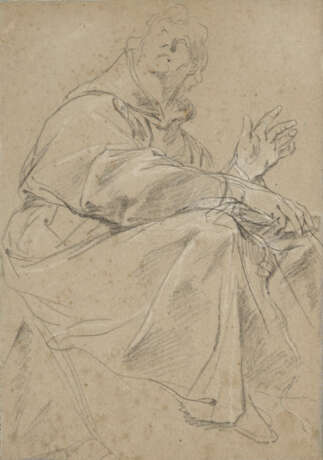ID 1173015
Lot 36 | ANTHONY VAN DYCK (ANVERS 1599-1641 LONDRES)
Estimate value
€ 100 000 – 150 000
Un moine franciscain, assis, levant les yeux
pierre noire, rehaussé de blanc, sur papier gris (anciennement bleu)
35,5 x 25 cm (14 x 9. 7⁄8 in.)
Provenance
Collection privée, Paris.
Further details
ANTHONY VAN DYCK, A FRANCISCAN MONK, SEATED, LOOKING UP, BLACK CHALK, ON GREY (FORMERLY BLUE) PAPER
In no period of his short but highly productive career did Van Dyck paint more religious works than in the few years between his return to Antwerp from Italy in 1627 and his departure to London in 1632. Many of these are large-scale altarpieces, commissioned for churches, which must have made his art – honed in the Antwerp studio of Peter Paul Rubens and later in direct contact with Italian art – for the first time accessible to a wide audience in his native Flanders (H. Vey in Van Dyck. A Complete Catalogue of the Paintings, New Haven and London, 2004, nos. III.1-III.53, ill.). The present drawing, a recent rediscovery, must date from these years, and be a study for such a painting, although it cannot at present not be related to any known composition by his hand. The kneeling young man, looking up to the sky in ecstasy, is recognizable as a Franciscan monk by his frock and the knot in the rope tied around his waist. He appears to be seated, perhaps on a rock. As is also the case with many of Van Dyck’s studies for portraits, the drawings focuses on the figure’s pose and drapery, while the face is outlined in a style at the same time minimal and highly effective.
Van Dyck picked up the habit of using blue paper while in Italy, and the support was chosen for several of his drawings from the so-called second Antwerp period, such as a sheet at the British Museum, London, inv. 1875,0313.45 (fig. 1; see H. Vey, Die Zeichnungen Anton van Dycks, Brussels, 1962, I, no. 130, II, ill.; and C. Brown, The Drawings of Anthony van Dyck, exhib. cat., New York, The Pierpont Morgan Library, and Fort Worth, The Kimbell Art Museum, 1991, no. 50, ill.). In that drawing, a study for a lost Lamentation formerly in the Berlin museum (Vey, op. cit., 2004, no. III.35, ill.), the lifeless body of Christ is executed in a more detailed style with vigorous strokes of black chalk heightened with white chalk, whereas the head of Saint John at upper right is done in a cursory manner comparable to that of the face in the present work. Their upward glance is one found in many of the figures filled with pathos in Van Dyck’s religious works of these years, such as the Virgin in the Virgin and Child at the Fitzwilliam Museum, Cambridge (inv. PD.48-1976; see Vey, op. cit., 2004, no. III.11, ill.), or in the Crucifixion at the Church of Saint Michael, Ghent (ibid., III.24, ill.); both the Virgin and Saint Francis in another Crucifixion in the Church of Our Lady in Dendermonde (no. III. 26, ill.); Christ in the Raising of the Cross in the Church of Our Lady in Kortrijk (no. III.21, ill.); or Saint John the Evangelist in a Crucifixion in the Palais des Beaux-Arts in Lille (inv. P.89), originally in the church of the Recollects in the same city (no. III.25, ill.). All of these works date from the last years of the 1620s.
More than three hundred drawings survive by Van Dyck, whose career was abruptly ended by an early death in 1641, but few important ones remain in private hands and have come on the market. With the exceptions of a study in compromised condition for an early Christ carrying the Cross (most recently at the sale Christie’s, Paris, 16 October 2016, lot 115) and especially of a drawn portrait of the engraver Willem Hondius that was be offered at Christie’s, New York on 1 February 2024 (lot 83), one has to go back several decades to find a drawing by Van Dyck sold at auction of a significance and similar size to that of the present sheet. Two smaller religious compositions sold recently are a pen sketch of the Rest on the Flight to Egypt (Christie’s, 5 December 2019, lot 14), and another sketch, also depicting the Holy Family (Christie’s, London, 5 July 2017, lot 56).
We are grateful to Christopher Brown and Martin Royalton-Kisch for endorsing the attribution, the latter on the basis of a digital image.
| Artist: | Anthony van Dyck (1599 - 1641) |
|---|---|
| Applied technique: | Chalk |
| Medium: | Acrylic glass, Paper, Plastic, Stone |
| Art style: | Old Masters |
| Place of origin: | Western Europe, Europe, The Netherlands |
| Auction house category: | All other types of objects, Paintings, Watercolors, Drawings, Drawings, Watercolors and drawings |
| Artist: | Anthony van Dyck (1599 - 1641) |
|---|---|
| Applied technique: | Chalk |
| Medium: | Acrylic glass, Paper, Plastic, Stone |
| Art style: | Old Masters |
| Place of origin: | Western Europe, Europe, The Netherlands |
| Auction house category: | All other types of objects, Paintings, Watercolors, Drawings, Drawings, Watercolors and drawings |
| Address of auction |
CHRISTIE'S 9 Avenue Matignon 75008 Paris France | ||||||||||||||
|---|---|---|---|---|---|---|---|---|---|---|---|---|---|---|---|
| Preview |
| ||||||||||||||
| Phone | +33 (0)1 40 76 85 85 | ||||||||||||||
| Fax | +33 (0)1 40 76 85 86 | ||||||||||||||
| Conditions of purchase | Conditions of purchase | ||||||||||||||
| Shipping |
Postal service Courier service pickup by yourself | ||||||||||||||
| Payment methods |
Wire Transfer | ||||||||||||||
| Business hours | Business hours
|












